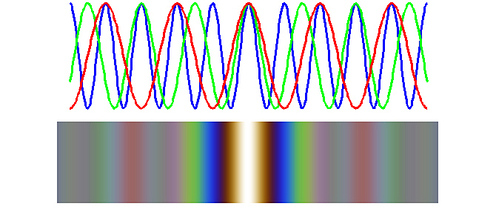
Case of white light
For white light, we can consider that each wavelengths of the visible spectrum constitutes a system of superimposed fringes. As long as the optical path difference
 remains smaller than the coherence length of the source, the field appears as colored fringes (see figure 24) referred to as white light fringes. When
remains smaller than the coherence length of the source, the field appears as colored fringes (see figure 24) referred to as white light fringes. When
 increases, the colors fade and we refer to them as bleached. Then, when the optical path difference becomes greater than the coherence length, the field appears uniformly white. This shade is referred to as higher order white. The fringes have disappeared, in other words, the modulation in the cosine has been reduced by the effect of the source's temporal coherence. For a white source where
increases, the colors fade and we refer to them as bleached. Then, when the optical path difference becomes greater than the coherence length, the field appears uniformly white. This shade is referred to as higher order white. The fringes have disappeared, in other words, the modulation in the cosine has been reduced by the effect of the source's temporal coherence. For a white source where
 and
and
 (see paragraph C.4 – Case of a rectangular spectrum distribution), the coherence length is given by
(see paragraph C.4 – Case of a rectangular spectrum distribution), the coherence length is given by
 , thus when the optical path difference exceeds 1 micron, the fringes disappear.
, thus when the optical path difference exceeds 1 micron, the fringes disappear.

If we analyze high order white color with a spectrum, we will see that all wavelengths between 400 nm and 800 nm are absent; those that verify the relation
 and that are hence “turned off” by destructive interference are missing.
and that are hence “turned off” by destructive interference are missing.